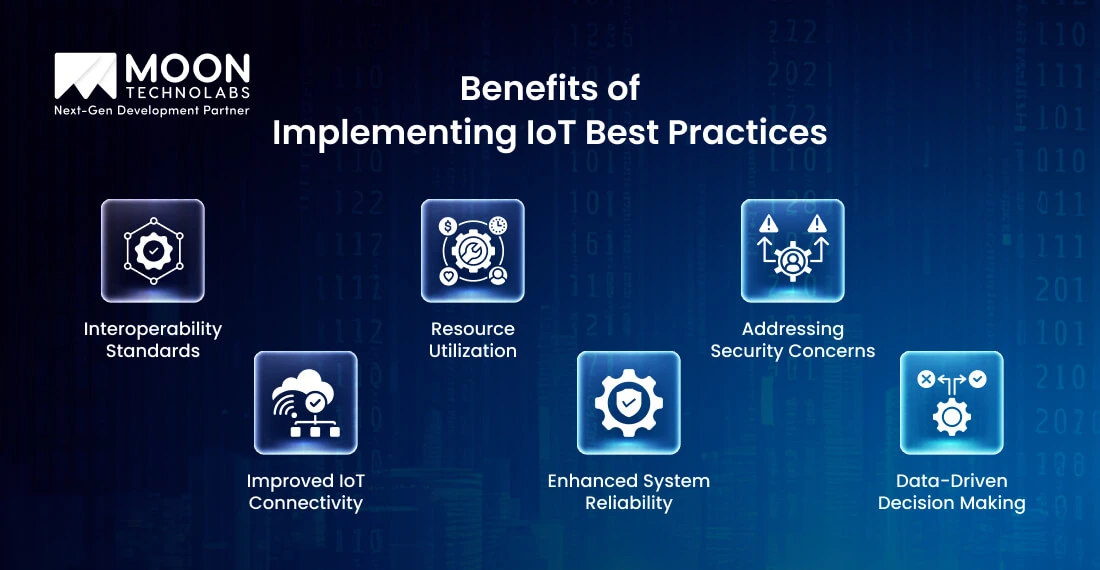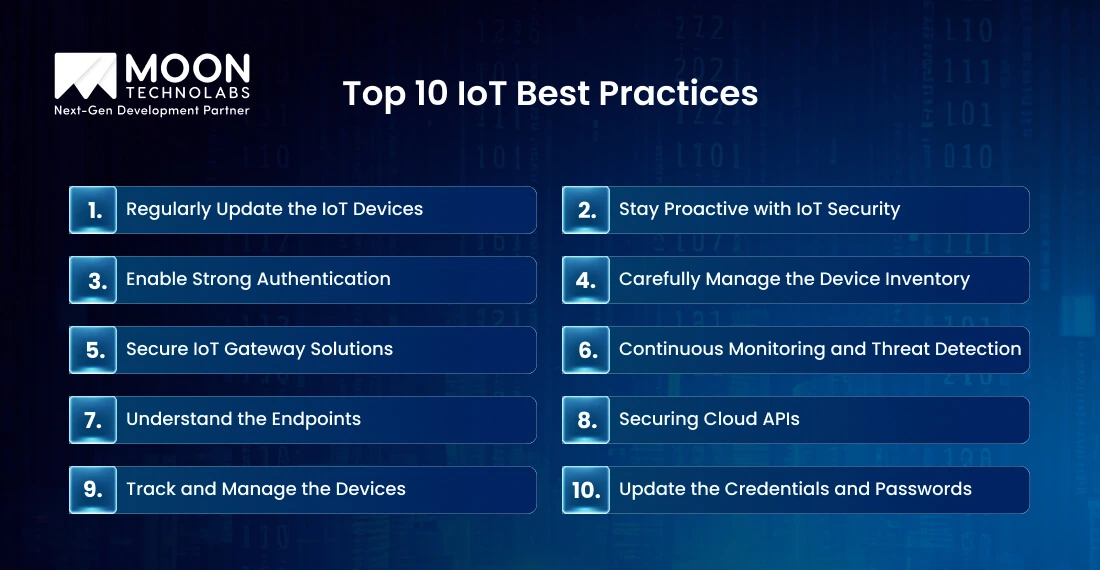Table of Content
Blog Summary:
In this post, we have covered IoT best practices and their great significance in harnessing the potential of this technology, which increases the growth of your business. You can also explore various advantages of implementing IoT practices in detail. Let’s explore them without wasting any more time.
Table of Content
From industrial automation to smart homes, the Internet of Things has witnessed rapid adoption in multiple sectors, offering greater convenience and efficiency. According to a survey conducted by ABI Research, the number of IoT connections is likely to increase from USD 19.5 billion in 2025 to USD 40.1 billion in 2030, at a CAGR of 16%.
The above data reflects the IoT’s undeniable dominance in the technological space. However, without the right IoT best practices, your organization faces security challenges, mishandled data, and operational inefficiencies.
Hence, to gain the maximum benefits from IoT, you need to understand these best practices before implementing them correctly. They can not only mitigate these risks but also enhance performance.
So, if you also plan to implement the IoT Best Practices, we have broken down some of the popular ones, which will help you understand them in depth and get started. Take a look.
The Internet of Things is a technique for connecting multiple devices for data exchange. The top IoT best practices include efficiency, security, and scalability. Let’s explore some of the important practices.
Implementing the following important practices can help an organization optimize the IoT ecosystem and enhance security, reliability, operational efficiency, etc.
Implementing the right IoT practices is necessary to ensure higher efficiency, automation, data-based decision-making, and more. Powerful cybersecurity measures are also necessary to protect against cyber threats.
Regular compliance and updates are necessary to boost the device’s longevity and performance. Efficient data management prevents overload and provides fully actionable insights.
Interoperability is essential to improve smooth communication between different platforms and devices. Whether you are an individual or a business, you can follow IoT best practices to increase the benefits of the Internet of Things.
Meanwhile, it also minimizes the overall risks while ensuring a more future-ready, reliable, and safely connected ecosystem.

Implementing the top IoT best practices can help businesses gain a plethora of advantages. We have discussed some of the top advantages in detail.
Integration of multiple IoT protocols and standards in different platforms and devices is certainly not easy when it comes to IoT adoption. Interoperability standards play a crucial role in ensuring IoT systems can communicate seamlessly. They minimize the complexity of integration and also increase efficiency.
Why is Standardization Necessary?
By implementing standard protocol on devices from multiple manufacturers, businesses find it convenient to avoid scenarios like vendor lock-in. It helps them achieve a highly flexible and scalable infrastructure.
Standardization is necessary for encouraging innovation. It also enables developers to create mind-blowing solutions that can connect smoothly across multiple apps and networks.
Another major advantage of IoT best practices is they focus mainly on resource utilization while improving operations and minimizing waste. Automated processes through IoT cause great cost savings in many industries, such as healthcare, manufacturing, logistics, and more.
Why Implement Resource Utilization?
In many industrial settings, predictive maintenance is necessary to minimize downtime and operational costs. For instance, IoT in smart cities can help build smart energy management systems to analyze and also control overall power consumption.
It causes sustainable practices as well as cost reduction. Businesses can optimize IoT systems for higher efficiency to gain a competitive edge by maximizing their productivity with minimized expenses.
Security has been the top priority in IoT deployment, mainly due to the vast amount of data produced through the connected devices. They could be accessing control mechanisms, regular firmware updates, or implementing powerful encryption.
Why Address Security?
Top security practices in IoT protect sensitive information from falling into the wrong hands. Implementing a zero-trust security model allows only authorized or authenticated devices to access the security network.
Those organizations that follow top security practices minimize the risks related to unauthorized access, data breaches, and malicious attacks and build a completely safe IoT ecosystem.
Smooth connectivity is necessary for IoT systems to function more efficiently. The right practices offer complete reliability, fully consistent data transmission, and communication between different endpoints across multiple networks and devices.
Why Optimize Connectivity?
Technologies such as Low-Power Wide-Area Networks (LPWAN), 5G, and edge computing can improve overall connectivity while minimizing overall latency.
Optimized connectivity allows IoT apps to function in real-time, making them highly effective and responsive in many industries, such as healthcare monitoring, autonomous vehicles, smart cities, and more.
Reliable IoT systems are pivotal to avoiding downtime and failure. However, they are expensive for most businesses. To offer higher reliability, you can implement top practices such as failover strategies, redundancy mechanisms, real-time monitoring, and more.
Why Deploy Reliable IoT Systems?
With the use of the best IoT system, businesses can easily find and resolve issues before they become bigger and also maintain a smooth operation. In the healthcare industry, quality IoT devices ensure higher accuracy in patient monitoring. Meanwhile, in many industrial settings, it plays a vital role in necessary, costly production halts.
IoT has the immense capability of connecting data, analyzing it thoroughly, and acting on huge volumes of data. Top IoT data practices allow businesses to make the right decisions based on the data.
How Data Drives Decisions?
Organizations can gather actionable insights to optimize supply chain management with IoT, improving customer experience and operational efficiency. With real-time data, organizations can easily respond to market trends and various evolving challenges.

After explaining the many benefits of adopting IoT best practices, it’s time to explain some of the popular practices. Below, we have discussed some of these practices that both individuals and businesses can follow to optimize security and performance.
You need to establish a proper routine for updating your devices based on the latest software patches and firmware. This is the core security aspect of the Internet of Things.
Manufacturers can release updates daily to address vulnerabilities and thus boost performance. Meanwhile, many IoT devices function with outdated applications, which makes them prone to cyber-attacks.
Our Advice: It’s advisable to replace all devices that no longer require updates. You can also check your manufacturer’s firmware updates regularly.
As mentioned, IoT security is meant to be robust and also an impeccable proactive strategy. Many connected devices in the Internet of Things gather and transmit sensitive data, making them a prime target for cybercriminals.
What to Follow: To make your IoT device security foolproof, you should follow a multi-layered security approach. You can conduct regular vulnerability assessments thoroughly and use world-class security solutions to detect and minimize threats in real-time.
A powerful authentication system is necessary to provide powerful authentication. A weak authentication mechanism causes major problems, such as breaches in IoT device security.
A large number of IoT devices come with default credentials that attract hackers to exploit them. A robust authentication system makes it possible for authorized systems and users to access the IoT network only.
We Recommend: Implementing multi-factor authentication (MFA) is the best practice for improving authentication. You can also use unique yet complex passwords for every device. However, avoid hard-coded credentials in many IoT devices.
Any business should have complete visibility into its Internet of Things ecosystem to maintain high-end functionality and IoT device security. Unauthorized devices create huge challenges without tracking vulnerabilities and updated inventory.
What to Adopt: The best practice is to maintain a real-time inventory of multiple connected IoT devices. You can also leverage various asset management tools to track their status and location. It’s a great idea to conduct a regular inventory audit to replace or remove many obsolete devices.
IoT gateways act as mediators between cloud services and edge devices. When left unsecured, they tend to become a single point of failure, enabling attackers to infiltrate the whole IoT network.
An Essential Step: Implement gateways with built-in IoT device security features, restrict access using intrusion detection systems and firewalls, and use encryption protocols to strengthen communication between different gateways and devices.
Real-time monitoring is necessary to discover and act on issues before they escalate to become bigger security concerns. The majority of IoT breaches can be detected easily, mainly due to the unavailability of monitoring mechanisms.
Must-follow Strategy: It’s advisable to use event management and security information tools. ML and AI can be used to create anomaly detection mechanisms. Logs need to be reviewed regularly to find any unusual activity.
IoT networks include various endpoints, such as actuators, sensors, user interfaces, and more. Every endpoint reflects a potential attack surface that requires an in-depth understanding and security of IoT devices.
A Proven Method: You can categorize endpoints according to their risk levels, secure encryption endpoints, and use authentication mechanisms. The right practice is to use network segmentation to isolate necessary endpoints.
The majority of Internet of Things devices depend on APIs and cloud-based platforms for data storage, analysis, and proper storage. When not structured properly, these APIs have the potential to become entry points for many cyber attackers.
How to Stay on Track: Implementing APIs requires the right practices and the latest and most powerful security policies. Role-based access control for API interactions is also advisable. Encrypting API communication protects data integrity and confidentiality.
Organizations must monitor the status of IoT device security, especially those in larger-scale deployments. Untracked devices have the enormous potential to become operational issues or security liabilities.
Keep in Mind: The easiest way to do this is to use various remote device platforms. You can also create a clear policy for replacing and decommissioning devices. It’s a good idea to analyze the devices’ health and track performance metrics.
A large number of IoT devices are available with default credentials. And the majority of hackers are already aware of this thing. So, it’s the best idea to change the default credentials. Besides, you can also implement powerful password policies that can certainly improve overall security.
Success Guideline: By changing your default passwords quickly after the installation, you can update both credentials and passwords without any hassle. It’s a better idea to use password managers that can generate and store strong passwords. Rotating your credentials periodically can easily minimize the overall exposure.
You Might Also Like:
Moon Technolabs Ranked as Top IoT Developers in USA by Techreviewer
How can your organization ensure seamless IoT integration while maximizing efficiency and security? The answer lies in choosing the right partner.
We are a proficient IoT development company that integrates cloud computing, AI, and data analytics to optimize automation and device communication. With high-grade solutions, we redefine the IoT best practices by delivering customized solutions that boost operational excellence, from industrial to smart home IoT.
At Moon Technolabs, we are committed to following the top practices, smooth integration, implementing high-grade security protocols, real-time data processing, and more.
Get in touch with us to improve your IoT strategy.
Looking to implement the best IoT practices for security and scalability? Our experts at Moon Technolabs provide tailored solutions to optimize your IoT ecosystem.
When you implement the right IoT best practices, you strengthen security while increasing device performance and smooth connectivity. Powerful authentication, daily updates, and proactive monitoring are essential to minimize risks and boost system reliability.
With the emergence of IoT, you need to stay ahead with these impeccable strategies. We never leave any stone unturned to help businesses secure their ecosystems, maximize efficiency, and thus ensure long-term success.
01
02
03
04
Submitting the form below will ensure a prompt response from us.